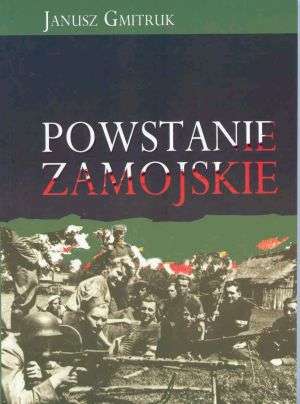Polokaust Zamosc Operation Guerrilla Counteraction Gmitruk2

Powstanie Zamojskie, by Janusz Gmitruk (ed.) 2003
Organized and Patriotically-Active Polish Peasantry. The Polokaust Partly Thwarted Locally: The “Zamosc Uprising” by Polish BCh (Peasant Battalion) Guerrillas
THE ZAMOSC UPRISING, a Polish-language book, is the most recent in a series of BCh (Bataliony Chlopskie) studies Janusz Gmitruk, all reviewed by me.
LOCAL POLISH PEASANT MILITARY ACTIVISM
Even before the restoration of Poland’s independence (1918), the Zamosc-area peasants had displayed considerable national consciousness and organizational sophistication. During the 1939 war, these peasants took care of wounded Polish soldiers, and, during the surrender process, enabled Polish officers to hide in order to avoid falling into German captivity and to later resurface as guerrilla leaders.
Owing to the fact that the peasants also collected and hid 1939 Polish Army weaponry, the weapons shortage faced by the later Polish guerrillas were not as acutely felt in the Zamosc area as elsewhere. For instance, in the immediate Zamosc area (June 1943), BCh guerrillas had 702 rifles, 18 light machine guns, 7 heavy machine guns, 73 pistols, 215 grenades, and 94,840 rounds of ammunition. (p. 27). The Underground gunsmiths, working under primitive conditions, did outstanding work in restoring concealed weaponry that had become unusable. (p. 147).
JEWISH PASSIVITY AND POLISH RESISTANCE
A Polish Underground document “Jez” (Jan Wojtal) stated that, if nothing else, Polish resistance would teach the Germans that the Poles, unlike the Jews, would not submit. (p. 89). In November 1943, there were 3,615 active BCh guerrillas in the entire region. By July 1944, the number had swelled to 11,853. Broken down by sub-regions (per the number of guerrillas), the 11,853 were at: Zamosc proper (4,000), Bilgoraj (3,503), Tomaszow Lubelski (2,350), and Hrubieszow (2,000). (p. 28).
POLISH GUERRILLA COMBAT AGAINST THE GERMAN OCCUPANTS
Early (mid-1942) BCh guerrilla actions included attacks on German police outposts, and the freeing of 20 captive Poles from the prison at Krynice. (p. 39). During the subsequent Odilo Globocnik-directed massive removal of Polish peasants and replacement by German colonists in the Zamosc region, the BCh guerrillas helped peasants flee their homes to evade deportation, and engaged in mostly hit-and-run arson attacks on German-settled properties. (p. 43). However, the BCh guerrillas also burned entire German-held villages, and assassinated several German colonists each at places such as Nawoz, Huta Komarowska, Janowka, Lipsko, and Wierzba. (pp. 41-42). Probably the largest such action took place at Cieszyn. (January 1943). It was burned, and 160 German colonists were killed. (p. 47).
The AK guerrillas (A. K., or Armia Krajowa) were also active in the Zamosc region. By late 1942, they had torched several German-settled villages, destroyed four bridges, derailed two trains, tore up railroad tracks at several locations, etc. (p. 46).
DEALING WITH THE UKRAINIAN GENOCIDAL TERROR
The Germans used Ukrainian collaborators to help “pacify” (destroy) Polish villages (p. 83), and replaced evicted Poles not only with Volksdeutsche but also with Ukrainian colonists, as proved by a German document (p. 93; see also p. 55). The Ukrainian fascist-separatist OUN-UPA (or UIU), working with local Ukrainian Nazi-collaborating police, extended its genocidal campaign from Wolyn (Volhynia) westward into the Zamosc region. Several tens of Polish villages were destroyed and about 8,000 Poles were murdered. (p. 58). Nevertheless, despite being out-gunned, the BCh succeeded in preventing the OUN-UPA from expanding its genocidal campaign further westward. (pp. 55-58).
SUCCESS! POLISH GUERRILLA ACTION STOPS THE GENOCIDAL GERMAN ZAMOSC OPERATION
German expeditions intended to repress and destroy the BCh and AK guerrillas failed to do so, and led to battles at such places as Wojda, Zaboreczno (see link above), Roza, Dlugi Kat, Dominikanowka, etc. (pp. 43-53). German and Polish casualties were comparable. The later massive German Operation Wehrwolf, caused the loss of 50% of all local Polish guerrilla forces (p. 54; which were later rebuilt: p. 55). However, combined with the decisive German defeat at Kursk, the Polish resistance had finally forced the Germans to discontinue Globocnik’s project.
The BCh and AK came out in open warfare against the Germans as part of Operation Tempest (Burza), and in opposition to their Operation Sturmwind. Polish guerrilla losses were grievous (500 dead), but so were the German ones (700 dead). (pp. 61-62).
THE BEGINNING OF THE COMMUNIST TERROR
Unlike the Communist GL-AL, the BCh and AK never advocated a “scorch earth” policy that would have Poles destroy all their properties to prevent them from falling into German hands. (p. 35). [The Communists wanted maximum suffering and need so that the populace would be in no position to challenge the coming Soviet-imposed Communist government.]
This work includes a detailed map of the entire Zamosc region. (pp 226-227). It shows hundreds of villages, identifying the ones that had been destroyed, Pole-evicted, and/or the sites of major BCh guerrilla combat.
To see a series of truncated reviews in a Category click on that Category:
- All reviews
- Anti-Christian Tendencies
- Anti-Polish Trends
- Censorship on Poles and Jews
- Communization of Poland
- Cultural Marxism
- German Guilt Dilution
- Holocaust Industry
- Interwar Polish-Jewish Relations
- Jewish Collaboration
- Jewish Economic Dominance
- Jews Antagonize Poland
- Jews Not Faultless
- Jews' Holocaust Dominates
- Jews' Holocaust Non-Special
- Nazi Crimes and Communist Crimes Were Equal
- Opinion-Forming Anti-Polonism
- Pogrom Mongering
- Poland in World War II
- Polish Jew-Rescue Ingratitude
- Polish Nationalism
- Polish Non-Complicity
- Polish-Ukrainian Relations
- Polokaust
- Premodern Poland
- Recent Polish-Jewish Relations
- The Decadent West
- The Jew as Other
- Understanding Nazi Germany
- Why Jews a "Problem"
- Zydokomuna